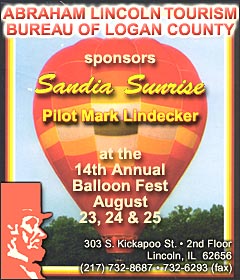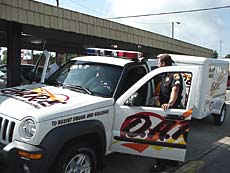|
Maxwell’s boyhood home at 184 Ninth St.
is the site for the marker, and the ceremony will take place there.
David Welch of Lincoln, who did all the research and fund-raising,
explained, "I always liked Maxwell’s writing and thought he was
deserving of this. He put Lincoln on the literary map."

Maxwell is known as a "writer’s writer"
for his spare, carefully crafted prose style. He has referred to
Lincoln as his "imagination’s home."
Barbara Burkhardt of Springfield, whose
critical biography of Maxwell is currently in press, will speak at
the ceremony. Burkhardt interviewed Maxwell several times at his
home in New York City. She teaches at the University of Illinois in
Springfield.
Barbara Jones, rare-book librarian at
the University of Illinois in Urbana/Champaign, has also expressed
interest in attending. In 1997 Maxwell donated his papers to the U
of I library. The collection includes many letters as well as
manuscripts. For 40 years, from 1936 to 1976, Maxwell was a fiction
editor for The New Yorker, working with such noted writers as John
Updike, John Cheever, Eudora Welty, Vladimir Nabokov, Mary McCarthy,
J.D. Salinger, William Carlos Williams, Tennessee Williams, John
O’Hara and Frank O’Connor. His correspondence with them is included
in the collection.
Tom Teague, executive director of the
Illinois State Historical Society, will also speak at the
dedication, and Welch will emcee. A reception will follow at The
Restaurant at the Depot.
In an interview reprinted in "The
Happiness of Getting it Down Right" (1996), Maxwell said of his
wife, the former Emily Gilman Noyes: "The most important living
reader I have is my wife. … Often she has said, when I was quite
pleased with something, ‘I think this is going to be one of your
best ones’ and so sent me back to the typewriter." They died just
eight days apart in July 2000. William Maxwell was 16 days shy of
his 92nd birthday.

Welch, who began the marker project in
1998, said the fact that the subject was still living created a
roadblock. The Illinois State Historical Society has never erected a
marker to a living person, Welch said, on the reasoning that "it is
impossible to fully assess a person’s contribution" until his or her
life is completed.
Maxwell lived his first 14 years in
Lincoln, and here occurred the most shaping event of his life — his
mother’s death from Spanish influenza when he was 10. Blossom
Maxwell died shortly after giving birth to her third son, Blinn. Her
death is incorporated into much of Maxwell’s fiction, including
"They Came Like Swallows" (1937), "Time Will Darken It" (1948) and
"So Long, See You Tomorrow" (1980), which won the American Book
Award.

The marker was cast in 2001 and Welch
has had it in his possession since November, but he delayed the
dedication until members of the family could be present. Maxwell’s
daughter Kate of Manhattan and his brother Blinn and his wife of
Oxnard, Calif., plan to attend. A second daughter, Brookie, also
lives in Manhattan.

Paid for by public donations, the
marker is in the same style as two others erected in the last five
years, to poet Langston Hughes at Central School and to the Niebuhr
family of theologians at St. John United Church of Christ. However,
unlike the others, the Maxwell marker will be in the smaller of the
two sizes sanctioned by the Illinois State Historical Society. Welch
said he chose the smaller version, with its limit of 100 words,
because the marker is to be placed on residential property. "For a
public building, I would have picked the larger size," he said. "But
in the yard of a private home, the smaller is more appropriate."
[to top of second
column in this article] |

Tim and Tami Kennett have owned the home for 11 or 12 years. Their
daughters Christina, Amanda and Amy were 6, 8 and 10 when they moved
in. Only Christina still lives at home. Tami Kennett said she
believes the house was built 25 to 30 years before the Maxwells
moved there in 1910.

The Kennetts did not know about the
Maxwell connection when they bought the house but learned of it soon
after. Tami Kennett said she has since read Maxwell’s works. "It’s
kind of eerie reading and picturing where he was and how he lived,"
she commented, noting references to the French doors, library and
other features of the house. She added that she doesn’t have a maid
as Maxwell’s mother did.

There is a bay window in the family
room, once the library. "I picture him sitting on that bay window,
reading," Kennett said. She hopes the marker will bring more readers
to Maxwell’s works.
Welch said his research for composing
the text of the marker included verifying the number of Maxwell’s
books and interpreting his feelings about the house as the last
place where he knew his mother. Welch based this interpretation on
published interviews as well as narrations within the works.
In late 1999 Welch sent Maxwell the
wording as he then planned it, and the writer made minor changes.
That text was about 90 percent the same as the final wording, which
reads:
|
WILLIAM MAXWELL
BOYHOOD HOME
WILLIAM MAXWELL (1908 - 2000),
AUTHOR AND EDITOR, LIVED AT THIS HOME FROM 1910 TO 1920.
MAXWELL OFTEN RETURNED TO THE HOME AND LINCOLN, ILLINOIS IN
HIS NOVELS AND SHORT STORIES. HIS MIDWESTERN CHILDHOOD,
PARTICULARLY THE LOSS OF HIS MOTHER IN THE SPANISH INFLUENZA
EPIDEMIC OF 1918, INFLUENCED MUCH OF HIS WRITING.
MAXWELL GRADUATED FROM THE
UNIVERSITY OF ILLINOIS, URBANA AND THEN SERVED AS FICTION
EDITOR FOR THE NEW YORKER FROM 1936 TO 1976. HE AUTHORED
FOURTEEN WORKS OF FICTION AND MEMOIR, WITH THE NOVEL, SO LONG,
SEE YOU TOMORROW, EARNING THE AMERICAN BOOK AWARD IN 1980. HIS
NAME IS ETCHED ON THE FRIEZE OF THE ILLINOIS STATE LIBRARY.
ERECTED BY FRIENDS OF WILLIAM MAXWELL AND
THE ILLINOIS STATE HISTORICAL SOCIETY, 2001 |
Welch said
he investigated having the home placed on the National Registry of
Historic Buildings, but the house has undergone too much renovation
to qualify.
[Lynn
Shearer Spellman] |
|

[Photo by Jan Youngquist]
The vehicle is a gift from the Local
Jeep Dealers Association. The process that led to the donation began
when Lincoln Police Chief Rich Montcalm gave Dan Row, owner of Row
Motors, 222 S. McLean St., Lincoln, a call inquiring about the
possibility of a vehicle. Row put Tim Centers, warranty
administrator at Row Motors, on the quest. Through lots of phone
calls, including to the president of the Local Jeep Dealers
Association, Steve Wilson of Wilson Chrysler Jeep in Clinton, it was
decided that the association would donate the vehicle out of funds
set aside for charity. Centers was pleased to make the presentation,
saying the association chose Lincoln because of the strong
organization the local DARE program has.

[to top of second column in this
article]
|
Sgt. Greenslate explained that by
offering three tiers, grade school, middle school and high school,
that puts the Lincoln program in the top 10 percent in the state.
They also do a VEGA (violence education and gang awareness) program.
He and the chief are planning to expand the program even more in the
future by offering a parents program that has been developed.
Chief Montcalm noted that he would like
to thank Mayor Beth Davis and the council for being supportive of
DARE and educating youth in the community on drug prevention and
awareness.

The Local Jeep Dealers Association is
made up of Jeep dealers from all of the 217 area code.
Lincoln IGA and Lincoln/Logan Crime
Stoppers donated the funds to purchase the trailer. The trailer
carries program literature, promotion materials and the
remote-controlled, helium-fillable DARE balloon.
Anyone in
the area and surrounding areas desiring the DARE officer and vehicle
to make a presentation at their special event can call Sgt.
Greenslate at (217) 732-2151.
[Jan
Youngquist]
|
|
He will be at the Lincoln Park District
Recreation Center from 9 to 11 a.m. talking to young people,
answering questions and giving autographs. Donations for the
youngsters will be $1 at the door.
He will also speak at a dinner at the
Lincoln Community High School cafeteria set for 6 to 9 p.m.
Donations for the dinner are $25, and tickets can be purchased from
Seelye, 732-8664; the First Baptist Church, 732-7409; Xamis Ford; or
Graue Chevrolet.
Altman, a commander in the U.S. Navy,
was born in Lincoln and dedicated in the First Baptist Church as an
infant. His parents, Fred and Sharon Altman, later moved to Pekin
and still live there.

[to top of second column in this
article]
|

[Photo provided by NASA]
[Scott Altman]
Altman has been in space three times,
twice as a pilot and once as commander for the mission to fix the
Hubble telescope. He lives in Houston.
The
fund-raiser is to buy land on Connolley Road to build a larger
church, Seelye said. The present site across from Central School has
no room for expansion or parking, she said.
[Joan
Crabb] |